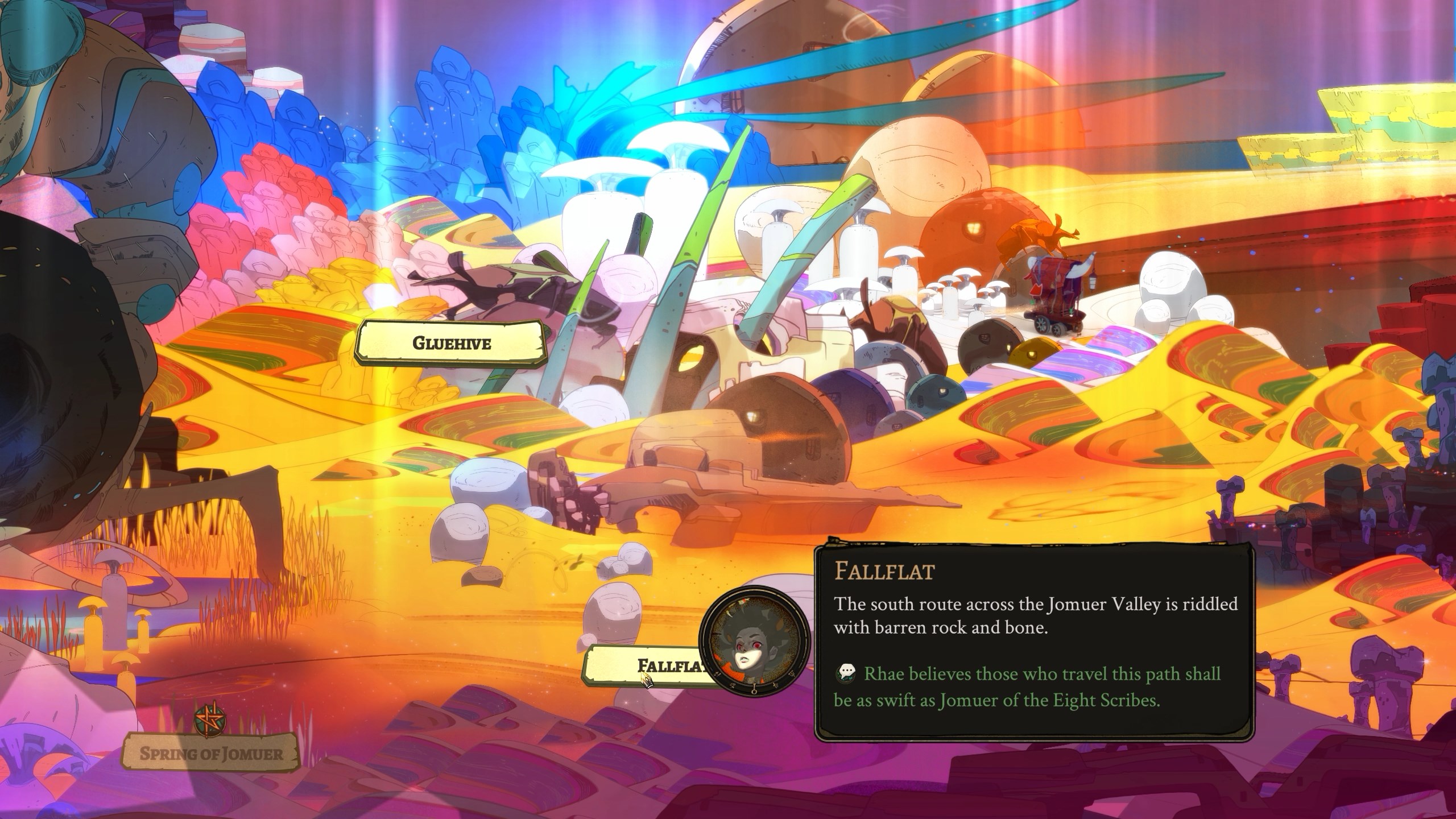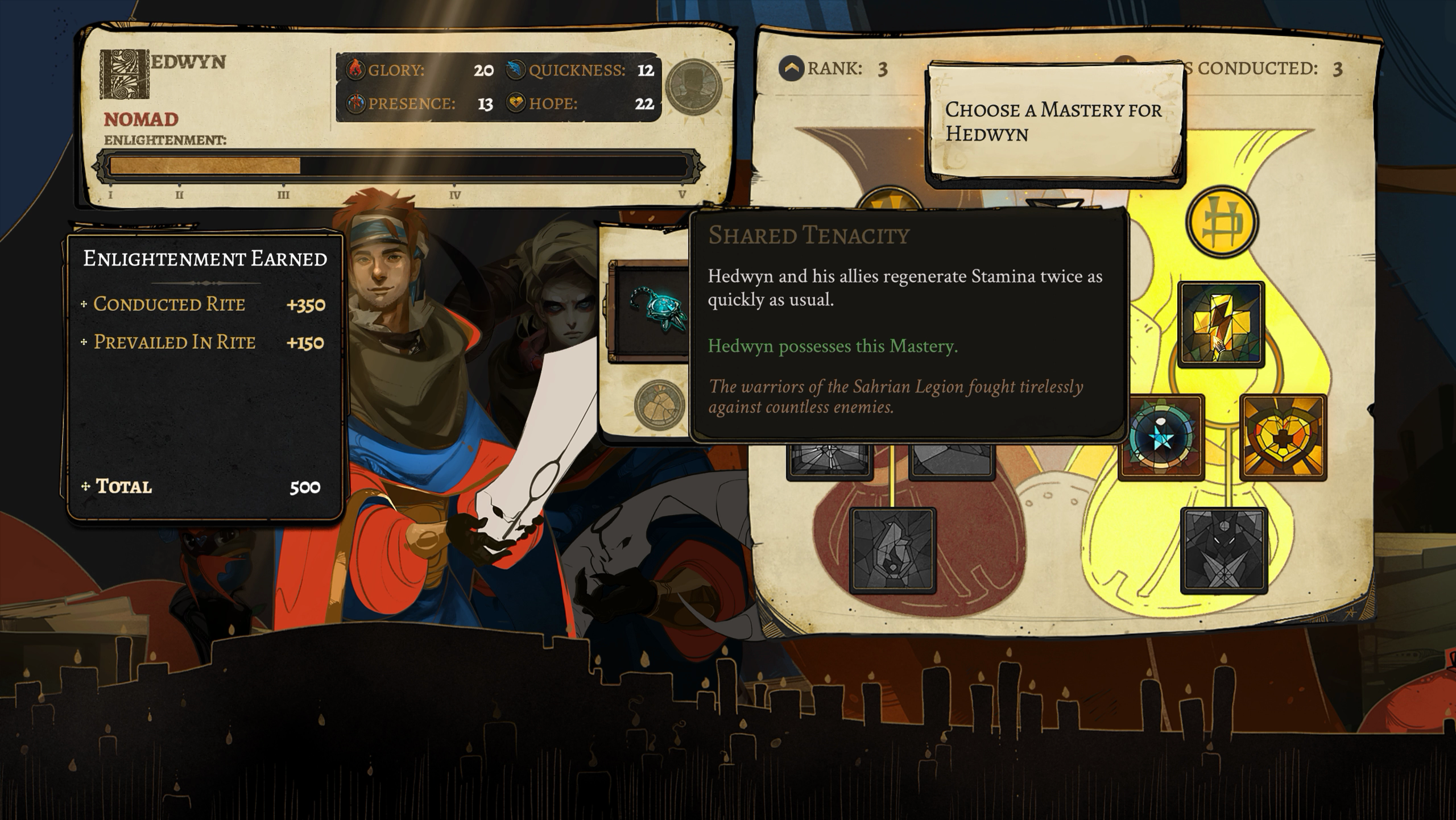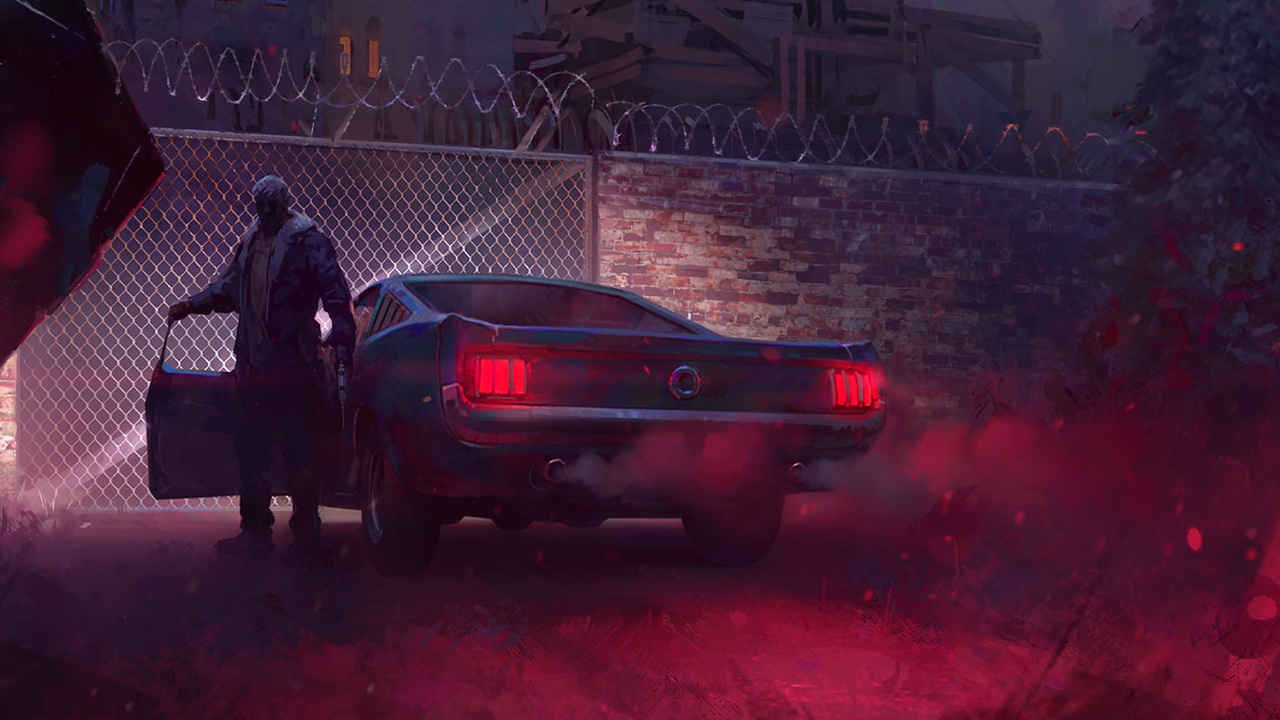Our Verdict
Pyre's campaign is repetitive and its combat never quite clicks, but a touching and thoughtful story makes it worth sticking through to the end.
PC Gamer's got your back
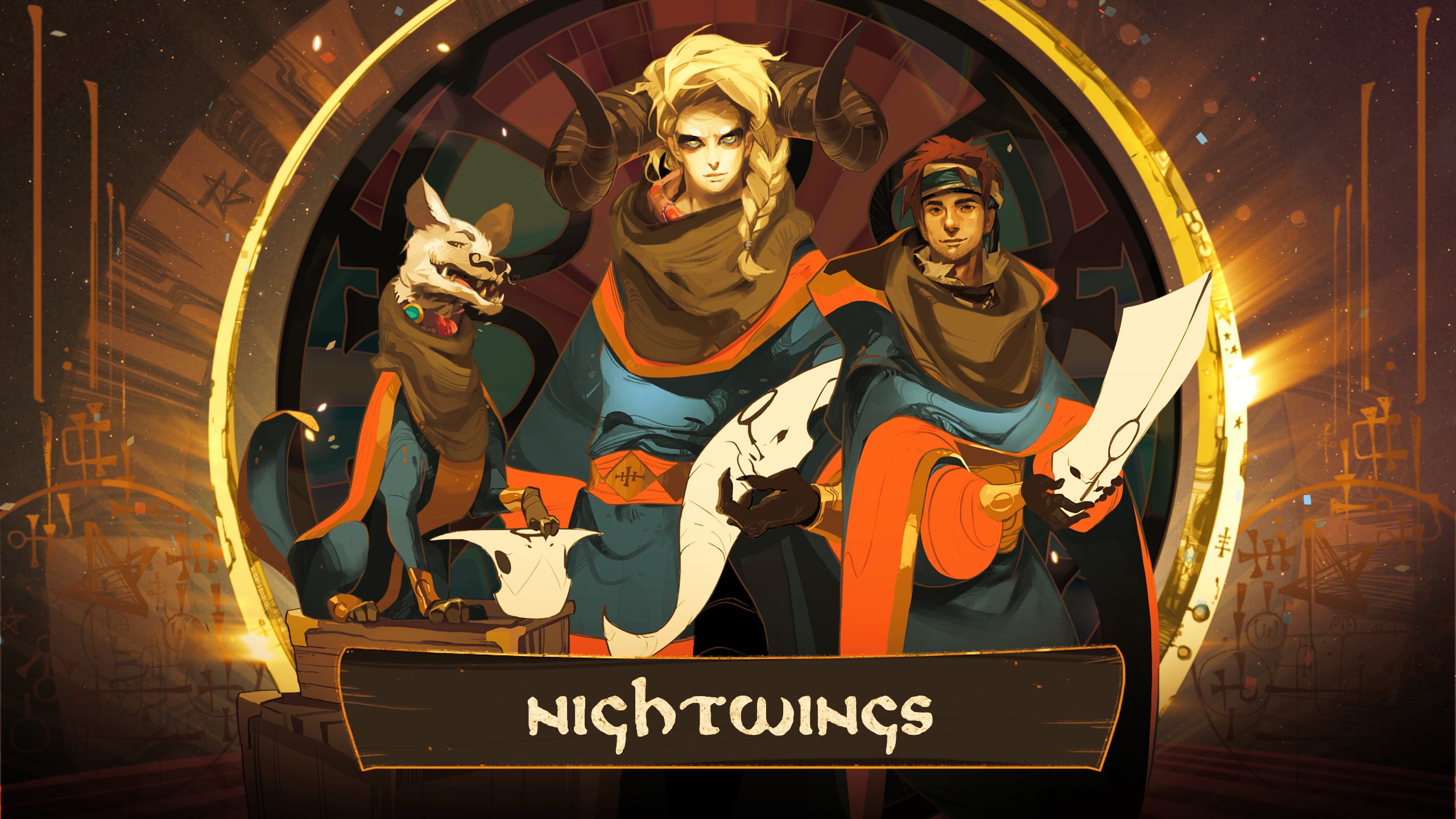
What is it? Half visual novel, half fantasy sports combat.
Expect to pay: $20/£15
Developer: Supergiant Games
Publisher: Supergiant Games
Reviewed on: Windows 10, 16GB RAM, GeForce GTX 980
Multiplayer: Two player local
Link: Official site
Buy: Steam
I spent a long time staring at my screenshots of Pyre before writing a word about it, because every frame captures a pure fantasy world so creative and otherworldly I envy the minds able to bring it to such vivid life. It's the kind of art that reminds you fiction can be anything, if only you have the power to imagine it. I'm also staring at my screenshots of the Downside, the purgatory world where Pyre takes place, because my opinion of it is as confused as Pyre's own identity.
Pyre is half fantasy sport, which is never as fun as it should be, and half narrative text adventure, which drags out a narrowly focused story across more hours than either half can really support. It's exquisitely made, yet neither half lives up to its potential.
It begins with a spark of hope for a trio of exiles in the Downside, as they find me near death in the desert. Through a series of dialogue choices I define the broad strokes of my history: like them, I'm a woman exiled from the Commonwealth, with either no memory or no desire to share my past. The one thing we both soon discover is that I'm a Reader, literate in defiance of the Commonwealth's laws, and by reading a magical relic called the Book of Rites I may be able to guide us to a way out of the Downside.
As in many visual novels, as the player I am literally the Reader. Characters address the screen directly as they share their stories or ask where we should go next. This starts with the trio of Hedwyn, a gentle, optimistic nomad; the imposing and gruff horned demon Jodariel; and dapper mustachioed dog-man Rukey Greentail, who invite you into their wagon and then ask your advice on which path through the Downside.
This setup sounds like a fantasy RPG take on The Oregon Trail, and that's what I expected at first. Hedwyn tells me life is harsh in the Downside, so surely our course through its beautiful wastes will matter. But it doesn't: most every choice of path in Pyre is binary and largely inconsequential. Within the first hour, you've essentially experienced the confines of play in Pyre. There is dialogue, and then there are the Rites, the strange fantasy combat sport that makes up Pyre's other half.
Unlike The Oregon Trail or a more traditional RPG, there is no survival mechanic, there are no quests or sidequests, no minigames, no cities to explore and really no exploration, period. Within a few hours I'd seen all of the Downside, but felt like I'd interacted with none of it.
Pyre is more visual novel than RPG, though you do assemble a party of characters as you progress. Instead of interspersing narrative sequences with puzzles, Pyre instead switches over to the Rites, a 3-on-3 competition that's basically wizard basketball. Each team's goal is to douse the opponent's pyre, which starts with a hundred hit points and takes damage as a character flings or runs the ball—orb—into its flames. There's disappointingly little connective tissue between the two modes. Most times, choosing a destination on the map just results in a minor buff or debuff to one of your party for the next round, an effect I found all but meaningless.
Keep up to date with the most important stories and the best deals, as picked by the PC Gamer team.
Larger characters like Jodariel move slowly but do more damage to the pyre. Rukey can briefly sprint at a much greater top speed, but deals less damage. Each character also has an aura around them that will 'banish' or briefly knock out the enemy if it touches them. This aura disappears while holding the orb, so winning the Rites comes down to how you use those auras offensively and defensively, and how skillfully you can avoid them by jumping or sprinting around enemies.
Building your team for the Rites is where Pyre most resembles an RPG. Each character in your party comes from one of the Downside's races, with a unique skillset and stat distribution and a simple skill tree to level up as they gain experience. Most of the races can jump and fire their aura in a straight line like an energy beam, but there are plenty of exceptions and twists on that basic setup.
One of my favorites is the slithering worm knight Sir Gilman, who's naturally the fastest member of the party. Instead of firing his aura, Gilman can detonate a trail he leaves behind him, banishing any enemies he passed in the last few seconds. Another is the Harp Pamitha, whose wings let her fly for several seconds instead of just jumping, and who can dash forward to banish any enemy in her path instead of firing her aura as a projectile.
Ability upgrades further augment these skills and change how you use them. For Gilman, I had to choose between the ability to teleport back to the starting point of his aura trail and the option to make the aura blast cover a wider radius. With Pamitha, I beelined through the skill tree to an ability that let her fly into the enemy's pyre and score without being banished—a quick and powerful way to score, because normally a character that enters the enemy's pyre has to sit out until the next point is scored.
I love the structure and strategy of Pyre's Rites. The problem is that I never found playing them fun enough to justify how much time Pyre devotes to them.
Each character can also equip a Talisman, and those add another layer of variety to team building. Hedwyn's all-rounder stats made him a regular on my team, so I equipped him with a talisman that gave him a chance to respawn immediately after being banished. Pamitha's dash move was a powerful offensive tool but she moved around the field too slowly, so I gave her a talisman that buffed her speed. Others I frequently used gave me money for each banishment in a match, restored some of my pyre's own HP when I damaged the enemy's, and made aura blasts penetrate obstacles on the field.
Like in their last game, Transistor, Supergiant Games' designers did a great job creating a diverse array of abilities that combine and change in interesting ways over the course of the game. I love the structure and strategy of Pyre's Rites. The problem is that I never found playing them fun enough to justify how much time Pyre devotes to them.
After more than 15 hours, I never got fully comfortable managing my entire party in the Rites. You can only control one character at a time, pressing a key or a controller button to swap between them. There's just enough of a delay here, and often just enough confusion about which I'm switching to, that I rarely made use of more than one at a time. In my best moments I'd position one character in midfield so their aura was an obstacle, or pass the orb back across the map to keep it out of enemy hands. But I never felt like I could switch control quickly enough to embody a defender in a snap and stop a quick enemy from jumping into my pyre.
Rites move with the speed and fluidity of a sports game, and controlling a single character feels tactical and responsive. It's almost akin to Rocket League, hurtling towards the goal while dodging, jumping, putting on a burst of speed. The analogy could even extend to an American football game, when you make a killer pass as the quarterback and then automatically control the receiver as you spin and sprint your way to the endzone. But imagine playing one of those games where the rest of your team stands still while you control them.
It's 3-on-3 Rocket League, but the other cars idle on the field. It's 3-on-3 basketball, but two of your players stand under the basket until you bring them to life.
Pyre was designed to play this way, of course, so it's not broken, but it never feels right to me. Switching characters isn't immediate enough to allow for full use of a team—and while I'm sure there will be high-level Pyre players who prove a counterpoint, the game never demands that degree of skill. At the same time, the Rites are too fast to offer the same satisfying planning-then-execution of RPGs and turn-based strategy games that Pyre draws some inspiration from.
I enjoyed the Rites less and less as Pyre went on, mostly because its structure simply doesn't change from the beginning. Click a location on the map; read some dialogue; play wizard soccer; repeat. That may sound reductive—after all, aren't most RPGs simply walking to a new place and fighting battles along the way?—but the lack of true exploration and side activities really hurts Pyre, as does the linearity of its story. The grind makes an already overlong campaign feel even longer.
The narrative half of Pyre is an endless stream of wonderfully written dialogue, imbuing each character with a personality magnified by simple but expressive character portraits. And while there are a few twists along the way, and some small stories that develop between characters, the trajectory of Pyre at the end is the same as it is at the beginning: you and your companions striving to complete the Rites and escape the Downside. It all plays out in a way that feels inevitable, which may be thematically appropriate for a game about destiny and mythological traditions, but doesn't make for an engaging story after a dozen hours.
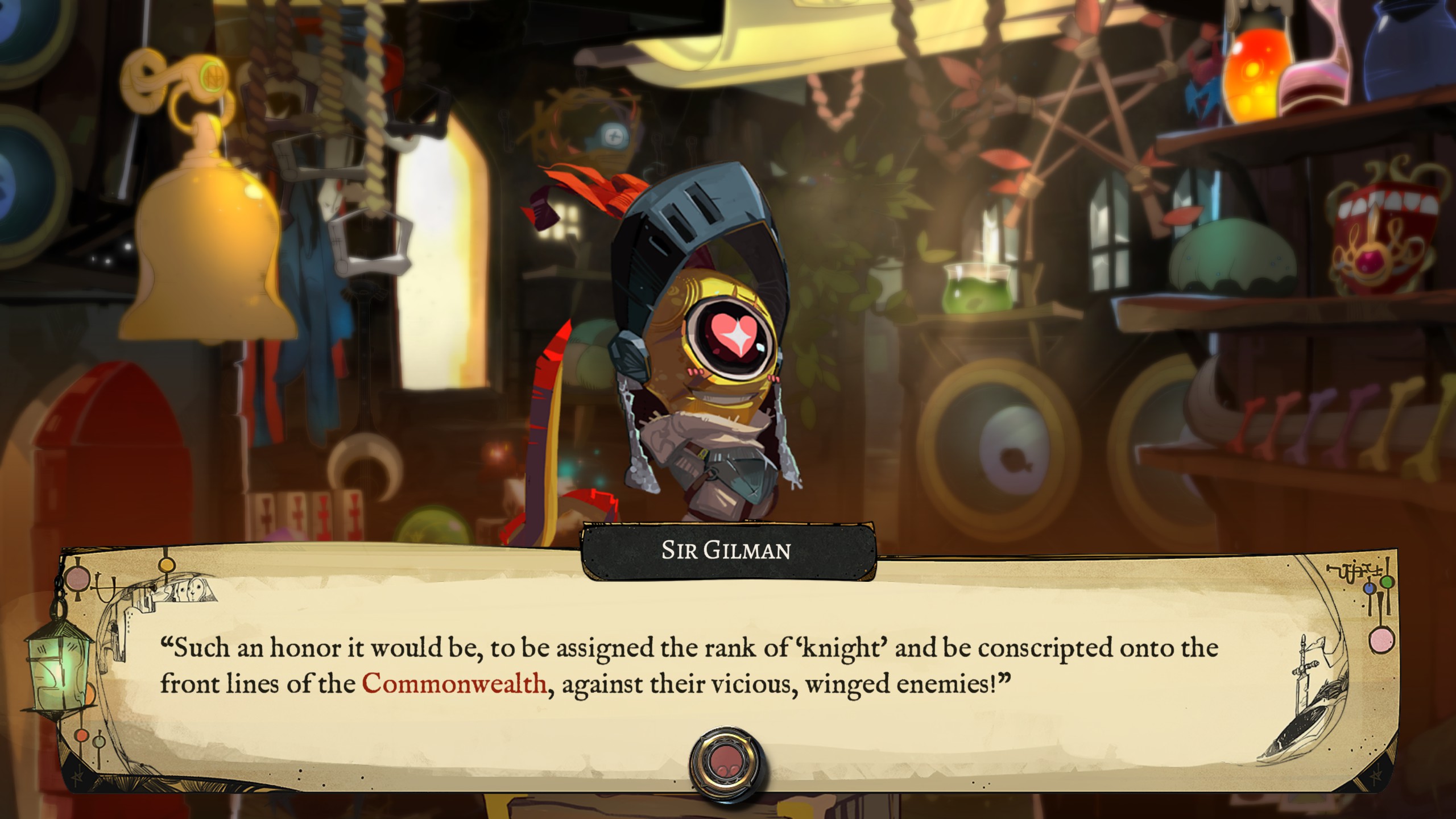
Even as I was bored with the predictable arc of Pyre's story, I admired how much work it took to make my personal version of this tale work. You see, your cast of exiles can one-by-one escape the Downside, but only if you win certain Rites. As I won again and again, my party shrank, and Pyre had to account for who remained. I was left wondering how differently this tale would play out if I lost those critical Rites, and it's a testament to how much I liked these characters that my heart clenched with stress when their freedom was on the line.
In the end I loved how their stories wrapped up, which made Pyre a strange contradiction for me: I preferred the destination to the journey. And as frustrated as I was with its lack of variety, I was just as in love with its small touches. Instead of a generic 'continue' text prompt, for example, every action in the story gets its own unique bit of writing. 'Seek now your destination.' 'Journey onward.' 'Accept this, for it is done.' I didn't think there was room to innovate the 'continue' button. I was very wrong.
That creativity is what I'll remember about Pyre as I look back on it. Pyre is clearly made with great skill and great care, blending art and music and words with more confident style than most games can hope for. But for all that work, its story and its combat never really meld, and neither was ever quite as fun or varied as I wanted them to be.
Pyre's campaign is repetitive and its combat never quite clicks, but a touching and thoughtful story makes it worth sticking through to the end.

Wes has been covering games and hardware for more than 10 years, first at tech sites like The Wirecutter and Tested before joining the PC Gamer team in 2014. Wes plays a little bit of everything, but he'll always jump at the chance to cover emulation and Japanese games.
When he's not obsessively optimizing and re-optimizing a tangle of conveyor belts in Satisfactory (it's really becoming a problem), he's probably playing a 20-year-old Final Fantasy or some opaque ASCII roguelike. With a focus on writing and editing features, he seeks out personal stories and in-depth histories from the corners of PC gaming and its niche communities. 50% pizza by volume (deep dish, to be specific).

